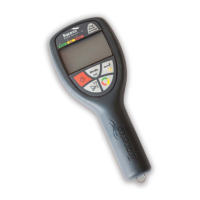13 MN1007-C
3.2 NORM assessment criteria
There are various measures of the radiological significance of NORM. The assessment criteria favoured by local
regulators regarding NORM limits can vary from region to region.
The NORM Monitor-IS is designed so that it will accommodate all current assessment criteria.
For each assessment criteria the NORM Monitor-IS provides user-configurable alarms which can be set to reflect
the local rule PASS/FAIL criteria.
[See section 4.8 for alarm setting options]
The range of known assessment criteria is described in the following section.
The operator should always seek guidance from the designated RPA, RSO or RPS when selecting an
instrument for measuring NORM and observe local procedures in relation to any planned radiation monitoring
operations.
3.2.1 Assessment using cps measurement
The NORM Monitor-IS may be operated in cps or cps minus background mode, with either the GM Probe or the
Scintillator Probe.
The PASS/FAIL alarm criteria are summarised in the following table. These assessment methods are commonly
used in the UK and Middle East oil and gas sectors.
Table 3 – Alarm options when using cps for NORM assessment
3.2.2 Assessment using surface activity (Bq/cm
2
)
Surface activity measured in Bq/cm
2
is less commonly used in NORM assessment but may offer the operator
useful information - provided the type of nuclide is known.
[See also Section 3.1 Probe Selection]
Operating mode Alarm type Description
Cps Level Alarm activated when total cps exceeds user-configured level
cps - background Level Alarm activated when cps above background radiation exceeds user-
configured level
cps - back
round Factor Alarm activated when a multiple of back
round radiation is exceeded.

